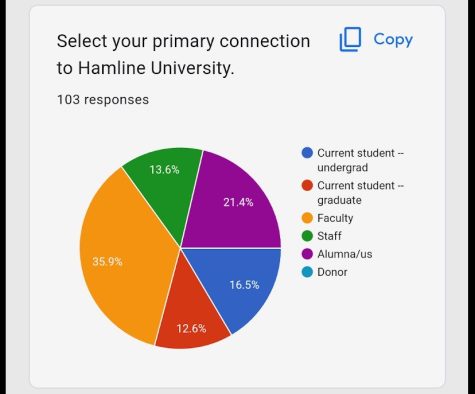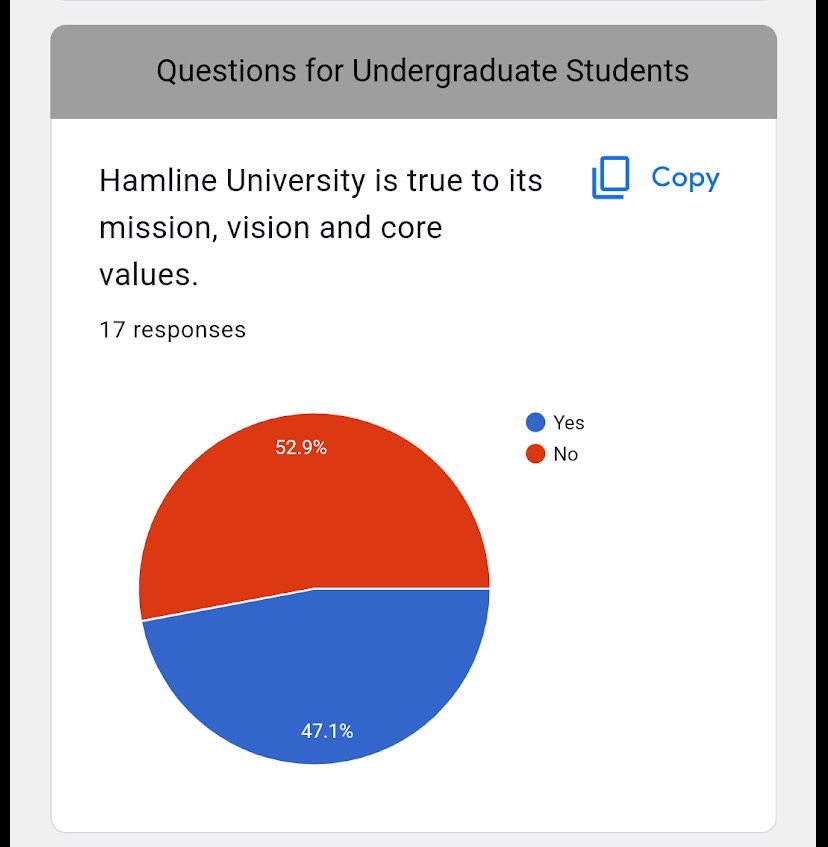Branding survey sends mixed messages
A screen grab taken on 9:03 a.m. on March 7 of the survey results for a question about Hamline’s Reputaion.
March 10, 2023
Hundreds of confidential comments and contact information of certain participants were accidentally exposed by a university brand survey this week. A large portion of the responses were critical of the university’s recent promotional pieces and messaging, either calling directly for change or expressing feelings of disappointment and frustration with Hamline.
This week’s Inside Hamline email, which was sent to the Hamline community by Director of Communications Jeff Papas on March 6 at 4:30 p.m., included a link to Hamline’s Brand Survey in which all faculty, staff, alumni, donors and current graduate and undergraduate students were encouraged to fill out, under the assertion that their feedback would remain confidential. Another Inside Hamline email was sent the morning of March 7 with this same form at the top of the email.
Through this Google Form, the University asked each constituency of the Hamline community to reflect on the messages that Hamline communicates to stakeholders and prospective students. Questions were a mix of short response questions and multiple choice. The form was prefaced with a short explanation, the last line of which promised anonymity.
“Thank you for your time and consideration. (Please note that your survey responses are anonymous unless you give us your contact information in the last section of the survey),” the Google Form read.
However, viewers found that at the end of the survey they were directed to a screen with two options: edit your response, or view previous responses. While the anonymity was not breached for every respondent, all participants were able to scroll through the submitted responses.
This allowed each person who completed the survey up until a little before 12:50 p.m. on March 7 to read all the responses the survey had collected including the first name, last name and email address of those willing to provide contact information.
Content of the survey varied between constituencies
The form was split into three sections. The first section split participant answers into respondent groups of graduate students, undergraduate students, faculty, staff, alumni and donors. When responses were made private on Tuesday afternoon, no donors had filled out the form.
The second section asked participants to reflect on the promotional messages that they perceived Hamline to be advertising, as well as to share their personal opinions on Hamline’s success or failures at fulfilling their advertisements. All of the questions in this section were required to be answered in order to submit the form.
Aside from slight language differentiation, alumni, undergraduate and graduate students were asked the same questions in this section. Only alumni were asked about preferred modes of communication from Alumni Relations. Staff and faculty were asked one less of the same questions as students. The omitted question was about how Hamline should be advertising themselves to prospective students. Donors were only asked six questions of the 10 or 11 that the rest of the respondents were asked.
The third section is where participants were asked to leave their name and email address if they consented to being reached out to by the University. This section was not required to complete the form, however this did allow anyone with access to the survey data at the end to see the identifying information of students, alumni, faculty and staff who volunteered it.

Exposed respondents react
The purpose of this survey was an opportunity for Hamline to receive “valuable feedback as Hamline refines its brand messaging for the future,” the Google Form read.
The Oracle reached out to some of the exposed respondents.
“Ironically, this is something I would add to my comments on the brand survey. Keep confidential surveys confidential! Just another thing to add to the list of things Hamline has been handling poorly. I hope that they at least release an apology to students and explain the situation,” said one individual whose name was exposed in an email.
Another participant was not as concerned with the exposure. As only a segment of the respondents entered their name and email, it would be extremely difficult to tie names to answers with only the data available to the public.
“I am indifferent to this new information because my answers were honest and respectful,” said another exposed individual in an email.
Hamline community members who felt secure enough to share their critical feedback, however, may be feeling the pressure of this risk.
“The instruction and intention will need to be made more clearly, I’d say. This is because some faculty, staff and students could be affected if someone copy and paste their posts out of context,” a third exposed respondent said in an email.
Is Hamline a victim of or at fault for this oversight?
The instruction and intention of this survey is still unclear. In a different Inside Hamline email from Papas to all employees on March 6, it is stated that Hamline is “working with a consulting firm on strengthening Hamline’s brand messaging for the future.”
The Oracle contacted Papas to ask whether the form was created by Hamline or the unnamed consulting firm.
“The survey was created internally and in conjunction with a partner firm we are utilizing for this exercise,” Papas said. “We do feel anonymity is important because it can encourage respondents to answer more freely. We are investigating the issue you raise.”

